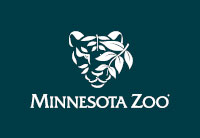Pollinator Conservation Initiative
The Minnesota Zoo’s Pollinator Conservation Initiative aims to secure a future for our state’s most imperiled pollinator species. In collaboration with many agencies and groups, we are working to save endangered prairie butterflies such as the Dakota skipper and Poweshiek skipperling through rearing and breeding programs. In addition, Zoo biologists are conducting research on Minnesota’s State Bee- the endangered rusty patched bumble bee.
Make a donation to support more conservation initiatives like this.

A reintroduced Dakota skipper butterfly.
Why are pollinators in trouble?
Did you know that the orange and brown Poweshiek skipperling, formerly one of Minnesota’s most common prairie butterflies, is now nearly extinct in the wild? Fewer than 500 likely remain in the world. Another prairie butterfly, the Dakota skipper, has also dropped to very low numbers and has vanished from most sites. Both are now listed under the U.S. Endangered Species Act, and are among 15 butterflies that are “Endangered,” “Threatened,” or of “Special Concern” by Minnesota.
Unfortunately, many other pollinator species also face uncertain futures. Globally, pollinator populations are shrinking and the reasons appear to be complex. Habitat loss, pesticide use, climate change and disease appear to be overlapping factors threatening many pollinator species around the world.

Zoo biologists are conducting research to protect at-risk prairie butterfly species.
In Minnesota, we have experienced the near total disappearance of native prairie which historically supported an abundance of wildlife, including many pollinators. Today, less than 1% of the historical prairie remains in the state. Many animals and plants that need prairie have declined or vanished, including the Dakota skipper and Poweshiek skipperling.
Why are pollinators important?
We can’t live without them! Pollinators like native bees, beetles, moths and butterflies, and birds and bats, are crucial players in functioning and healthy ecosystems. They help plants reproduce, keeping our world vibrant and beautiful- and delicious! It is estimated that one out of every three bites of food humans consume depend on pollinators. Some of our favorites, like cocoa beans, are entirely dependent on services provided by pollinators. A world without pollinators would be a world without chocolate.
Pollinators also help stabilize natural ecosystems which clean our air, filter our water, and boost our soils. They act as an important food source for many other species of wildlife. And pollinators have long held significance in many cultures. The world we recognize and cherish today is largely dependent on the health of pollinators.
What is the Minnesota Zoo doing to help?

Rusty patched bumble bee on bee balm.
The Pollinator Conservation Initiative at the Minnesota Zoo has created the world’s first rearing and breeding programs for Dakota skipper and Poweshiek skipperling to help save them from extinction. Zoo biologists study wild populations of prairie butterflies to assess their status and the threats they face. By rearing these butterflies during their sensitive caterpillar stages and eventually releasing them back to the prairies they have vanished from, this program is doing vital work for some of the most endangered butterfly species in the world.
In addition, Zoo researchers are studying other Minnesota pollinators, including the endangered rusty patched bumble bee. Through regular surveys on Zoo grounds and development of research protocols, the Pollinator Conservation Initiative is helping the scientific community better understand the reasons for this species’ decline and ways we might take action to protect it.
What can you do to help?
The decline of these butterflies and other pollinating insects is alarming, but there are ways you can help.
- Plant for pollinators! Butterflies and other pollinators need resources for food and shelter. You can help by growing native plants in your yard and garden. Check out our Plant for Pollinators page to learn more.
- Reduce or eliminate pesticide and fertilizer use. Chemical pesticides are a cause of pollinator decline and can hurt many other species of wildlife as well. And fertilizers often pollute our lakes and rivers which can harm the remaining habitat that pollinators rely on.
- Be a messy gardener! In the spring, delay garden cleanup until nighttime temperatures are consistently above 50°F, allowing overwintering pollinators time to emerge. In the fall, leave dead and standing plant matter in your gardens. It creates great habitat for our overwintering beneficial insects.
- “Get to Know Your Butterfly Neighbors” with this downloadable guide (en Español Conozca a sus Mariposas Vecinas). Free printed versions of this pamphlet are available at the Minnesota Zoo.
Key Zoo Staff:
Erik Runquist, Butterfly Conservation Biologist, Minnesota Zoo
Cale Nordmeyer, Butterfly Conservation Biologist, Minnesota Zoo
Seth Stapleton, Director of Conservation and Research, Minnesota Zoo
Key Partners:
Assiniboine Park Zoo
John Ball Zoo
Michigan Nature Association
Michigan Natural Features Inventory
Michigan State University
Minnesota Department of Natural Resources
The Nature Conservancy
Nature Conservancy Canada
Springfield Charter Township
U.S. Fish & Wildlife Service
Funding and Support:

![]()
![]()

















